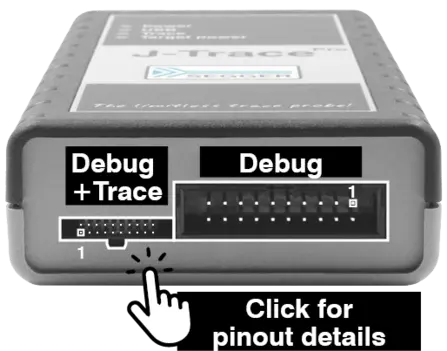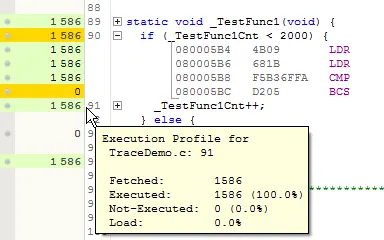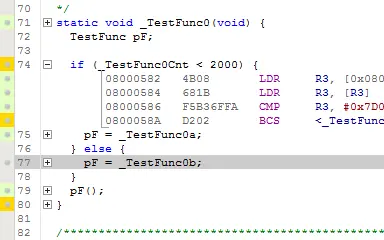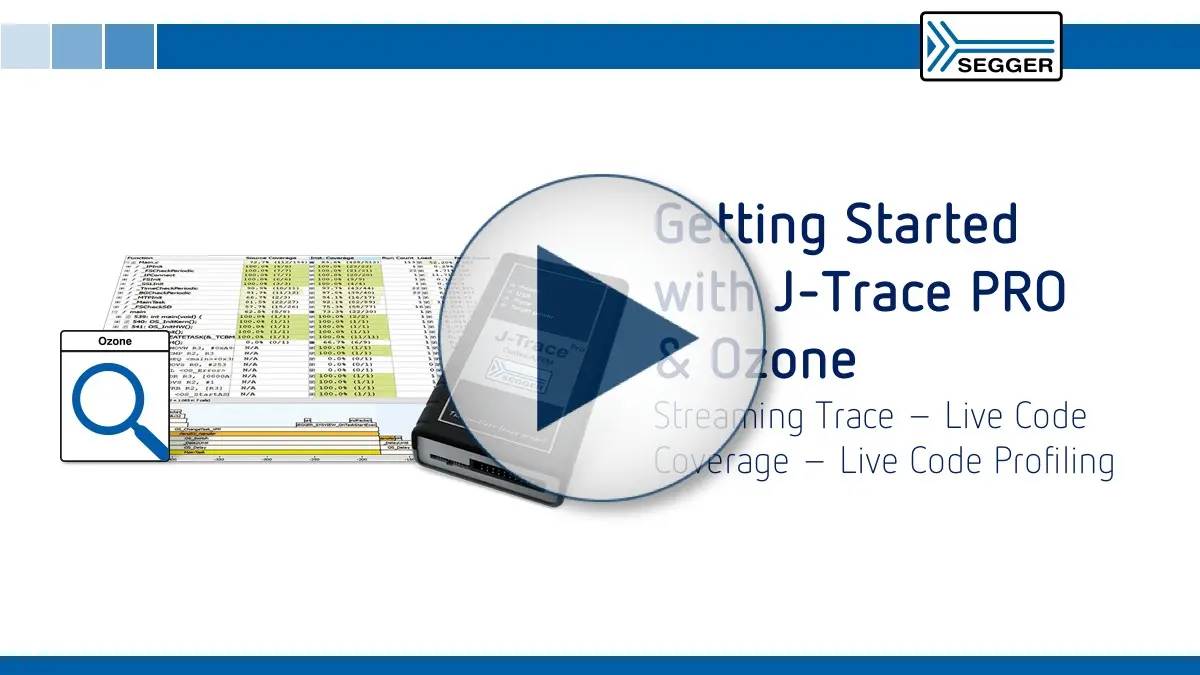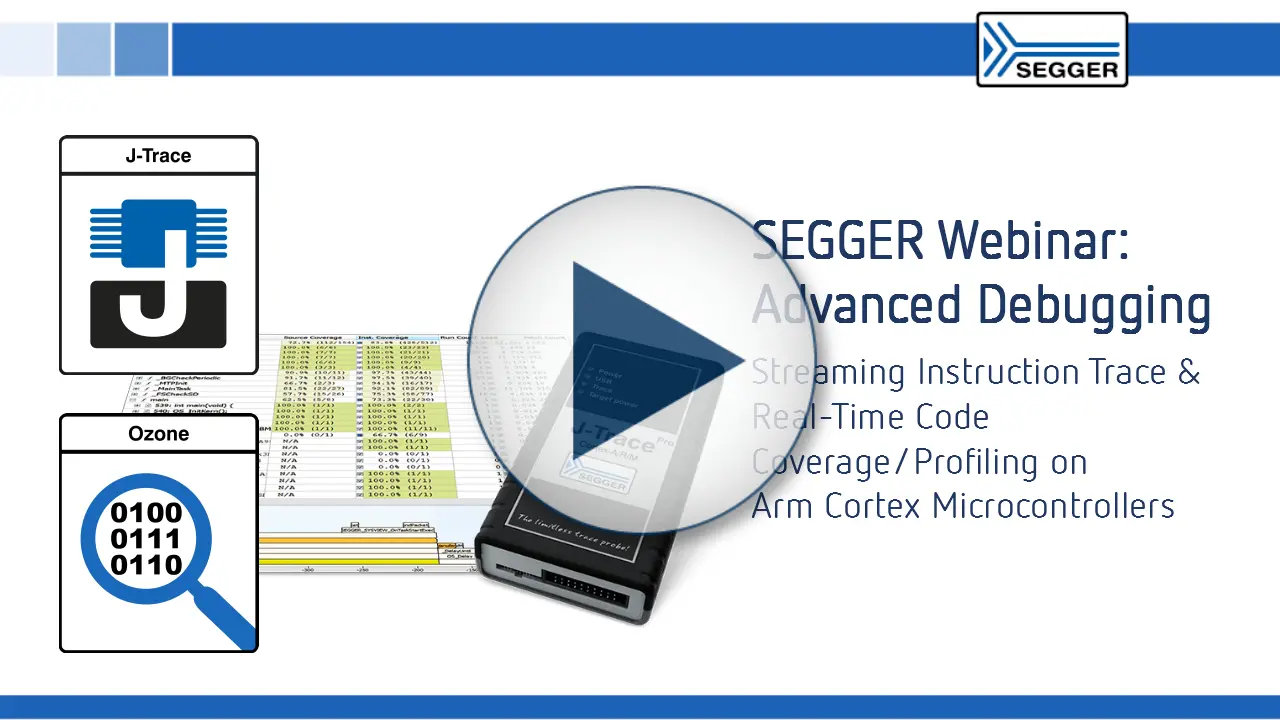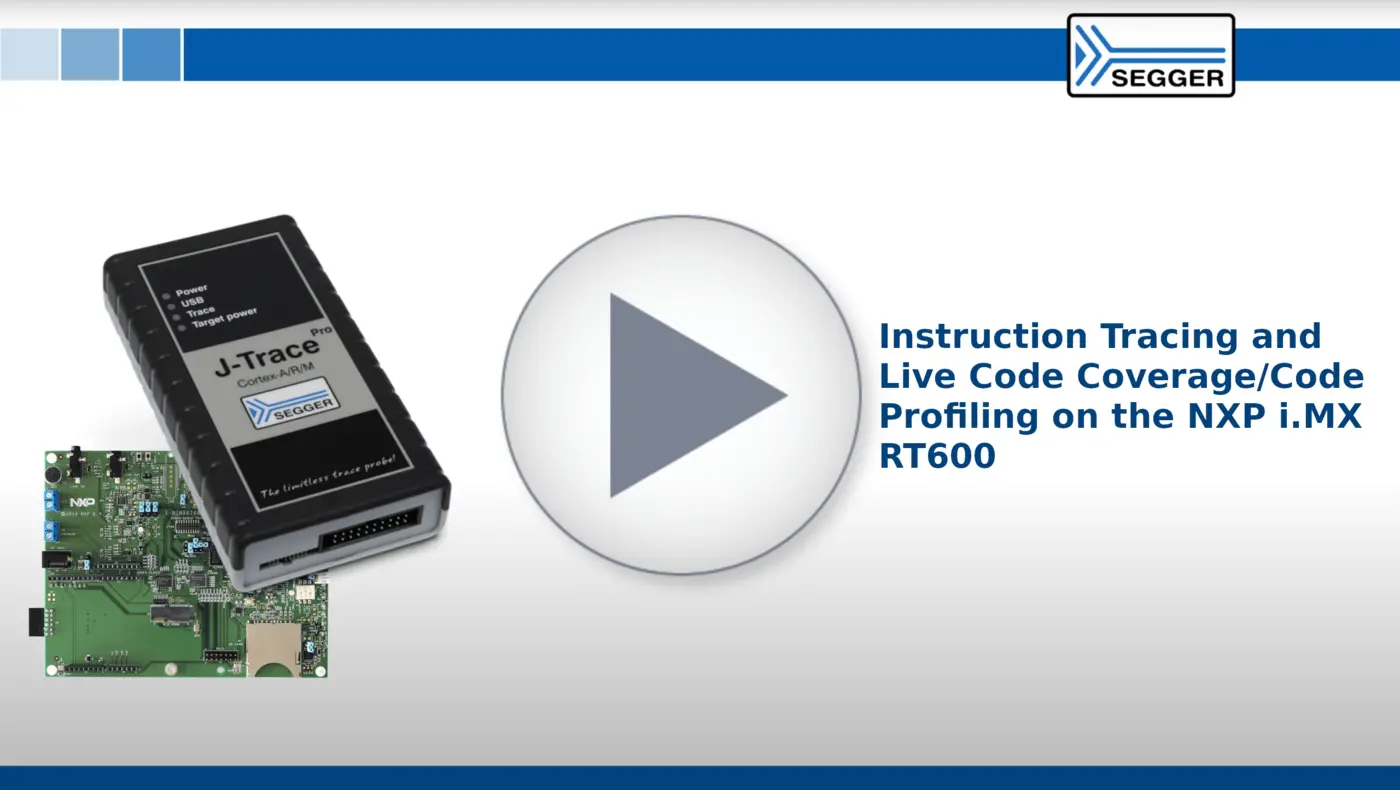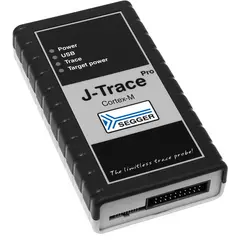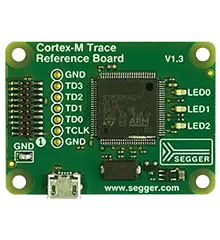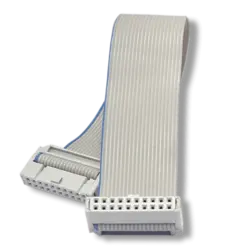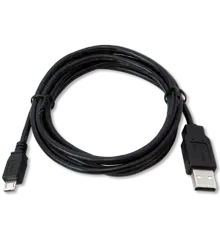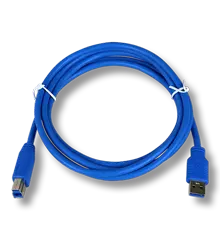J-Trace PRO Cortex-M
The leading trace probe
J-Trace PRO for Cortex-M-based microcontrollers enables continuous streaming trace for code development and optimization.
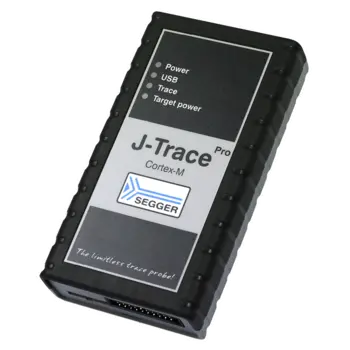
Overview
SEGGER's J-Trace PRO can capture complete traces over long periods — thereby enabling the recording of infrequent, hard-to-reproduce bugs. This is particularly helpful when the program flow ‘runs off the rails’ and stops in a fault state.
It also supports extended trace features, such as Live Code Coverage (so engineers have visibility over which parts of the application code have been executed) and Live Code Profiling (providing visibility as to which instructions have been executed and how often, so hotspots can be addressed and optimization opportunities identified).
The J-Trace PRO Cortex-M provides support for Cortex-M-based microcontrollers. The SuperSpeed USB 3.0 interface of J-Trace PRO Cortex-M enables continuous streaming trace via USB with the full trace clock. Streaming in real time allows for data capture over long periods of time because there is no limit set on the amount of trace data. This gives you all the insight you need to develop and optimize your code.
Key features
- Streaming trace probe with SuperSpeed USB3.0 interface and Gigabit Ethernet
- Download speed up to 4 MB/s
- Unlimited breakpoints in flash memory (Flash Breakpoints)
- Use with Ozone and J-Flash
- Real-time streaming at full System Clock
- Fine-tune applications with Live Code Profiling
- Instruction-level code coverage to satisfy regulatory requirements
- Unlimited trace to isolate & identify hidden code defects
- Supports Cortex-M targets
- Full J-Link debug functionality
Debug and trace connectors
J-Trace has two connectors. The pinout of the debug and trace connector is in the SEGGER knowledge base. The debug connector is for debug only and can be used with target adapters for J-Link.
Please note that only one connector can be used at a time.
Supported devices
SEGGER's J-Trace PRO supports tracing on a wide range of Cortex devices.
Core or device not listed? Please don’t hesitate to contact us.

Software
All software is included free of charge.
For every J-Trace PRO, the J-Link Software and Documentation Package is available here:
Multi-platform
As a multi-platform solution, J-Trace PRO Cortex-M comes with the setup and control software for Linux, macOS and Windows. Software and firmware updates are included. Similarly, use on all currently supported target devices, and any that will be added, is also included.
J-Flash
J-Flash is a part of the J-Link Software and Documentation package and allows the programming of the internal and external flash memory of a microcontroller-based embedded system via J-Trace.

Flash Breakpoints
The J-Trace PRO Cortex-M comes with an additional feature, called Unlimited Flash Breakpoints, which allows the user to set an unlimited number of breakpoints when debugging in flash memory.

Ozone — The multi-platform debugger and performance analyzer
Ozone is a full-featured graphical debugger for embedded applications. It includes all well-known debug controls and information windows, and enables the best performance of J-Link debug probes and J-Trace trace probes. With Ozone it is possible to debug any embedded application on C/C++ source and assembly level. The Ozone Trace Tutorial allows developers to test the streaming and live analysis features of J-Trace PRO.
Instruction tracing
With streaming trace data users get deep insights into any application running on the target device whilst offering additional, powerful debug strategies to apply. It enables a far-reaching, yet complete, analysis of such issues, offering fast and efficient data analysis, ensuring higher productivity and also lowering development risks and costs.
Live Code Profiling
Code profiling details which instructions have been executed and how often. Users can address application runtime hotspots and identify opportunities to optimize them. It is all about measuring the execution time and frequency of functions, blocks and instructions and highlighting where computing time is spent. These profiles can later be exported using a tool like the Ozone debugger, for documentation and analysis purposes.
Live Code Coverage
Through Live Code Coverage, engineers gain fully accurate information about how much of a source line, block, function, or file has been executed on a target application. It is this information that makes it possible to detect code that hasn’t been covered by tests — even code that may be unreachable. This enables a fast and efficient way to improve the code or to create a suitable test suite for uncovered blocks.
Trace reference boards
Trace reference boards are optimal for simple and portable trace demos. These boards allow testing and verification of trace setups within minutes. They can also be used as a reference for custom hardware projects as the trace reference boards are optimized for best trace signal quality.
All trace reference boards come with an example project that runs out-of-the-box. For easy setup the boards can be powered using a J-Trace PRO V2 or later.
Media gallery
Technical specifications
| Specification | Value | |||||||
|---|---|---|---|---|---|---|---|---|
| Supported OS | Microsoft Windows (x86/x64), Linux (x86/x64/Arm), macOS (x86/Apple M1) | |||||||
| Electromagnetic compatibility (EMC) | EN 55022, EN 55024 | |||||||
| Operating temperature | +5°C ... +60°C | |||||||
| Storage temperature | -20°C ... +65 °C | |||||||
| Relative humidity (non-condensing) | Max. 90% rH | |||||||
| Mechanical | ||||||||
| Size (without cables) | 123mm x 68mm x 30mm | |||||||
| Weight (without cables) | (without cables) 120g | |||||||
| Available interfaces | ||||||||
| Ethernet interface | Gigabit | |||||||
| USB interface | USB 3.0, SuperSpeed | |||||||
| Target interface | JTAG/SWD 20-pin (14-pin adapter available) JTAG/SWD + Trace 19-pin | |||||||
| JTAG/SWD interface, electrical | ||||||||
| Power supply | USB-powered (max. 400mA) | |||||||
| Target interface voltage (VIF) | 1.2V ... 5V | |||||||
| LOW level input voltage (VIL) | VIL <= 40% of VIF | |||||||
| HIGH level input voltage (VIH) | VIH >= 60% of VIF | |||||||
| Reset type | Open drain with 100 Ohms series resistor. Can be pulled low or tristated | |||||||
| JTAG/SWD interface, timing | ||||||||
| Data input rise time (Trdi) | Max. 20ns | |||||||
| Data input fall time (Tfdi) | Max. 20ns | |||||||
| Data output rise time (Trdo) | Max. 10ns | |||||||
| Data output fall time (Tfdo) | Max. 10ns | |||||||
| Clock rise time (Trc) | Max. 10ns | |||||||
| Clock fall time (Tfc) | Max. 10ns | |||||||
| Trace interface, electrical | ||||||||
| Power supply | USB-powered (max. 400mA) | |||||||
| Target interface voltage (VIF) | 1.2V ... 5V | |||||||
| Voltage interface low pulse (VIL) | Max. 40% of VIF | |||||||
| Voltage interface high pulse (VIH) | Min. 60% of VIF | |||||||
| Capacitive load | 3 pF J-Trace + 8 pF cable (typical) | |||||||
| Trace interface | ||||||||
| Max. trace clock frequency | 150 MHz | |||||||
FAQ
Q: What is the advantage of using the J-Trace PRO over other trace probes?
A: One of the biggest advantages of the J-Trace PRO is its streaming trace capability. Streaming trace allows for continuous live trace analyses, enabling debugging for even the most complex problems.
Q: What are the other differences to the older J-Trace for Cortex-M?
A: J-Trace PRO can now work with trace clocks of up to 150 MHz (300 MHz CPU clock) and is equipped with Gigabit Ethernet for streaming trace and remote debugging. Its debug interface speed has also doubled; additionally J-Trace PRO has more options for configuration and troubleshooting which is easily available through the integrated web server. For more information take a look at our J-Trace vs. J-Trace PRO comparison.
Q: Can I use the J-Trace PRO as a debug probe?
A: Yes. The J-Trace PRO includes all capabilities of the J-Link debug probes and comes with all licenses, such as for Unlimited Flash Breakpoints. It can be used with the J-Link software as well as with any tool that supports the J-Link.
Q: Can the J-Trace PRO be used with any IDE?
A: Yes. The J-Trace PRO can be used with all common IDEs, just like any J-Link debug probe.
Q: Can any IDE be used for tracing as well?
A: Unfortunately most IDE vendors do not offer trace analysis features. If they do, it is only to a limited degree.
Q: What can I use for tracing and analysis?
A: We recommend using the graphical standalone debugger Ozone. It supports all J-Trace PRO capabilities and compliments them with its advanced analysis features. Ozone can be used independent of a compiler, with the output of any IDE or toolchain. It can also be used completely free of charge with a J-Trace PRO, even for commercial use.
Q: What do I need in order to trace with a J-Trace PRO?
A: Just connect the target device and start debugging. J-Trace PRO is designed to simply get working. It can be up and running in less than 10 minutes.
Q: Where can I find trace-related troubleshooting information?
A: Tracing is a very hardware-dependent debug technique, and some target hardware modifications or designs can cause issues when trying to set up the trace debug interface. To give our customers an easy-to-use troubleshooting platform with the most asked questions answered, we have created the following setup page: Setting up trace.
Any more questions? Please contact us.
Q: Are there any trace example projects that I can use for orientation?
A: Yes, every J-Trace PRO Cortex-M gets shipped with a Cortex-M Trace Reference Board. An example project is part of the J-Trace tutorial. We also created a list of tested devices that each come with an example project that runs out-of-the-box with a J-Trace PRO and Ozone. The list is available here and is updated regularly.
Q: My device is not on the tested devices list, what can I do to get an example project for it?
A: The trace-capable MCU market is growing and it is becoming harder to keep track of all devices. If we don't happen to have a trace example for your particular device, please feel free to contact us.
The requirements for adding a new example project are:
- Must be supported by J-Link software: overview of supported CPUs and devices
- The target hardware must be publicly available and an evaluation board.
- Trace pins must be physically connected to the trace debug interface.
Q: What is the maximum voltage that can be handled by the galvanic isolation of the Ethernet?
A: The Ethernet data lines are isolated as required per IEEE 802.3 (test voltage 1500 Vrms for one minute). Note that this is NOT valid for the Ethernet shield that has a direct electrical contact to the USB shield and a resistive and capacitive coupling to probe GND. For an effective isolation, you need to use an unshielded twisted pair Ethernet cable.
